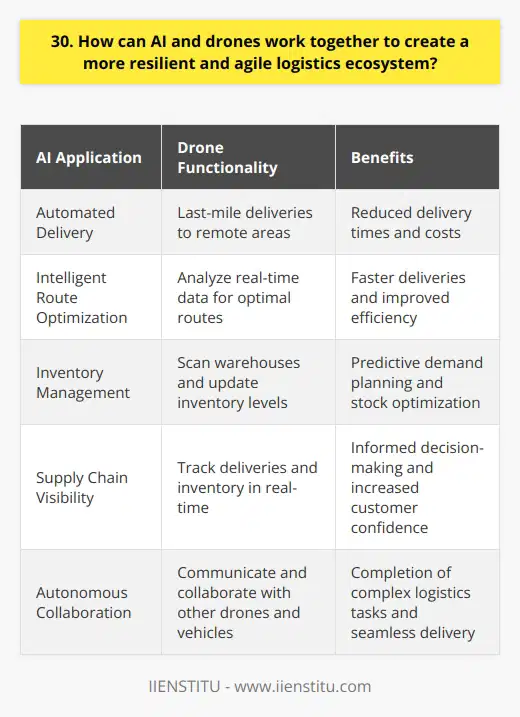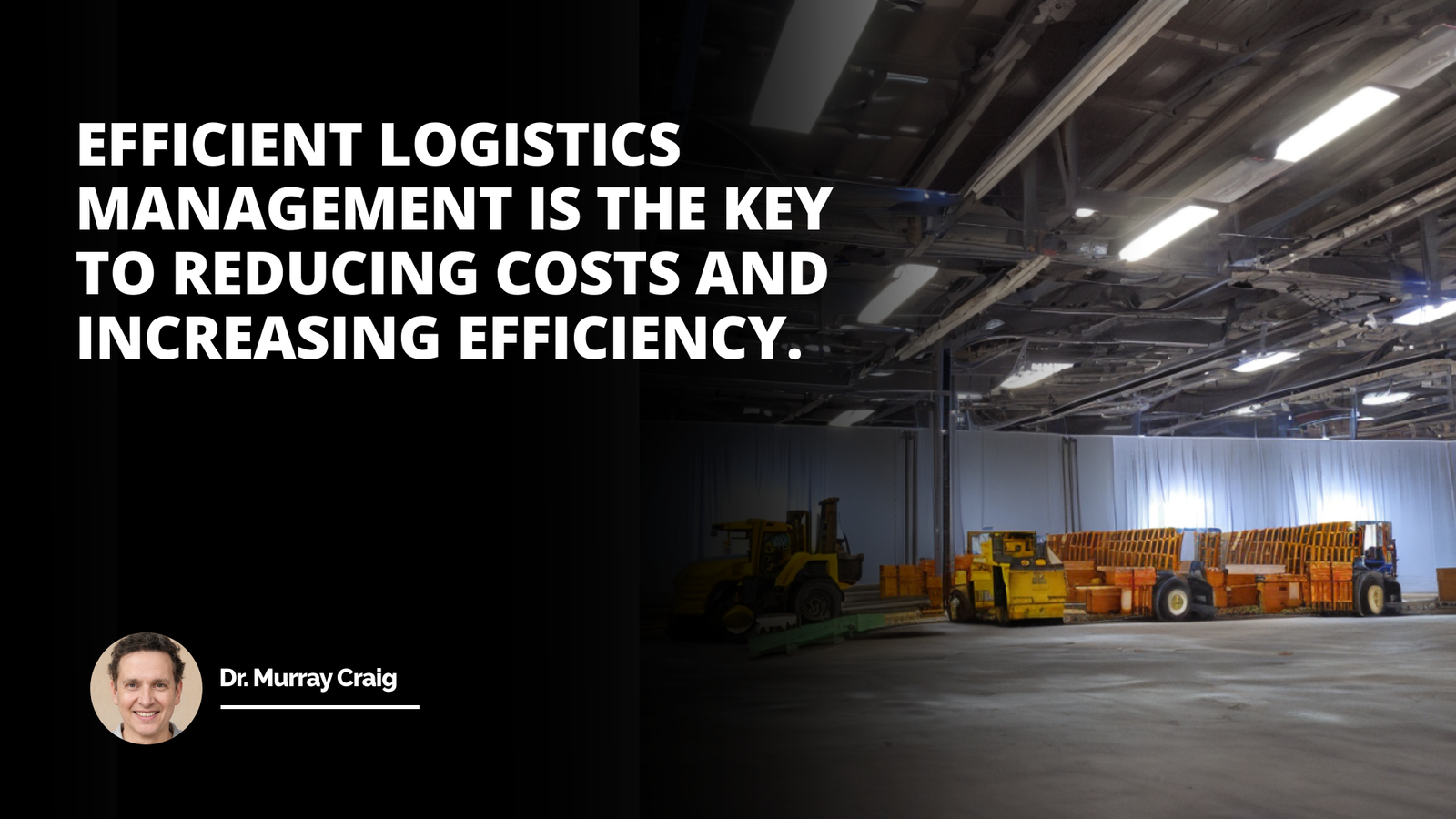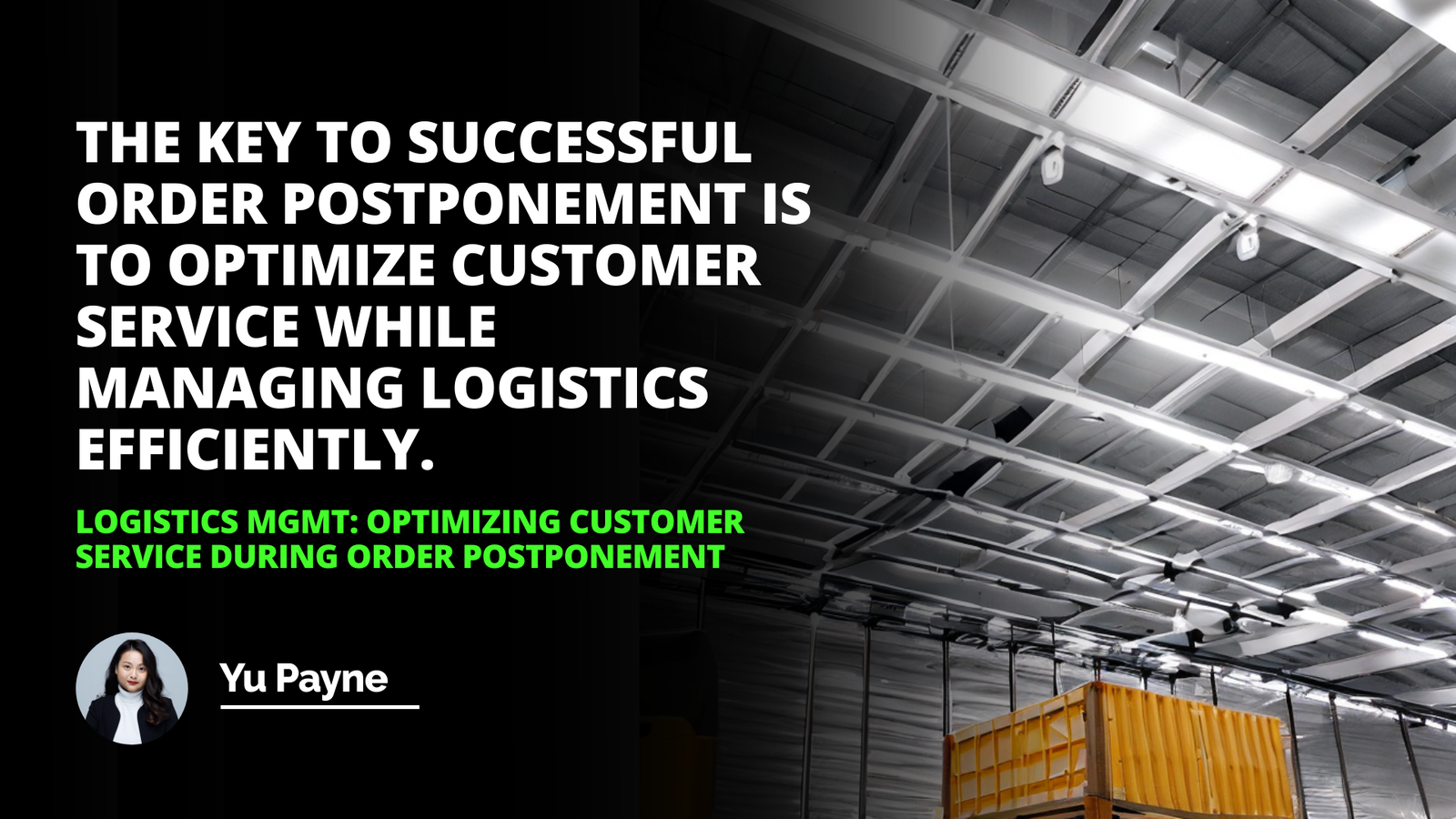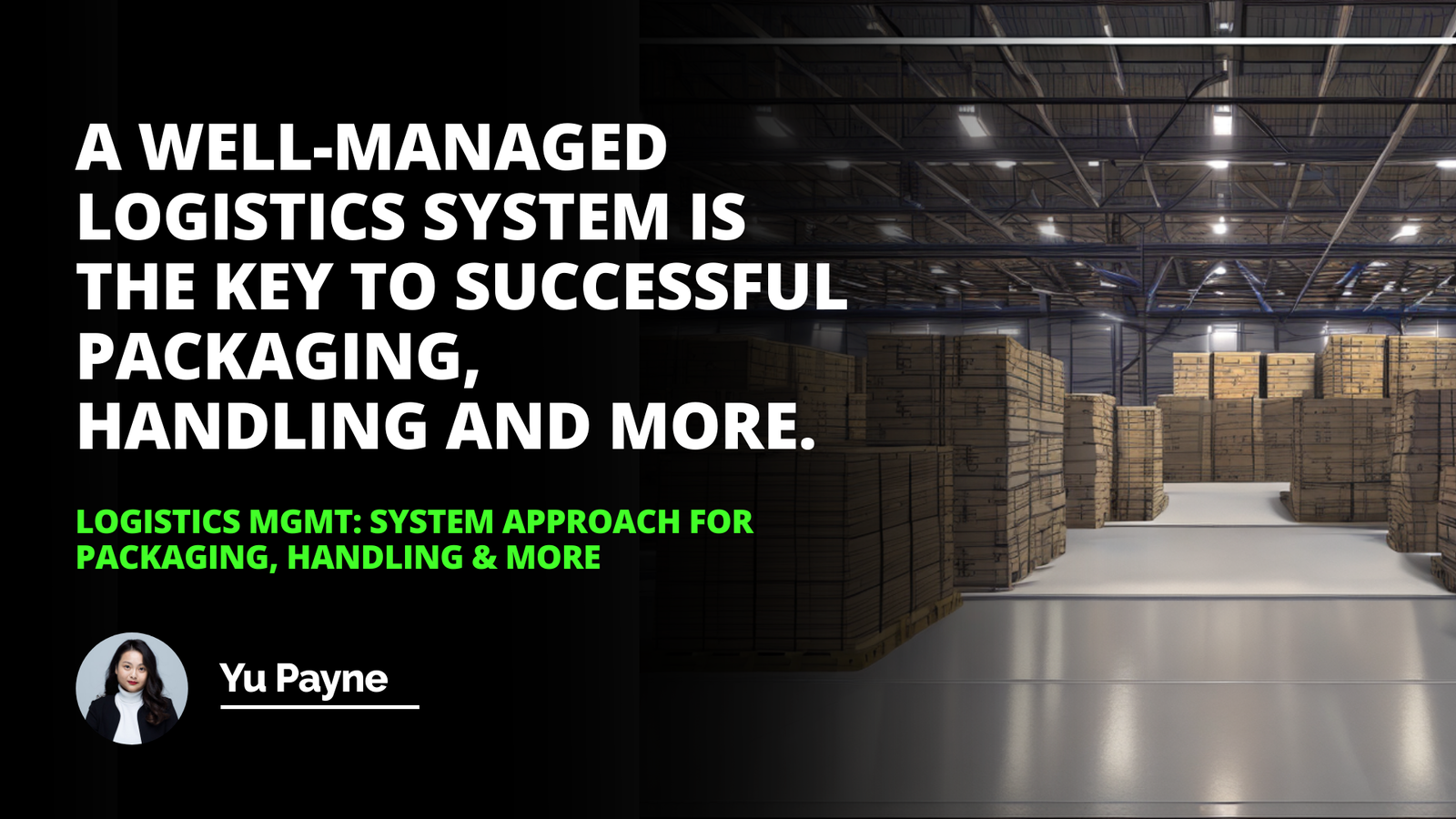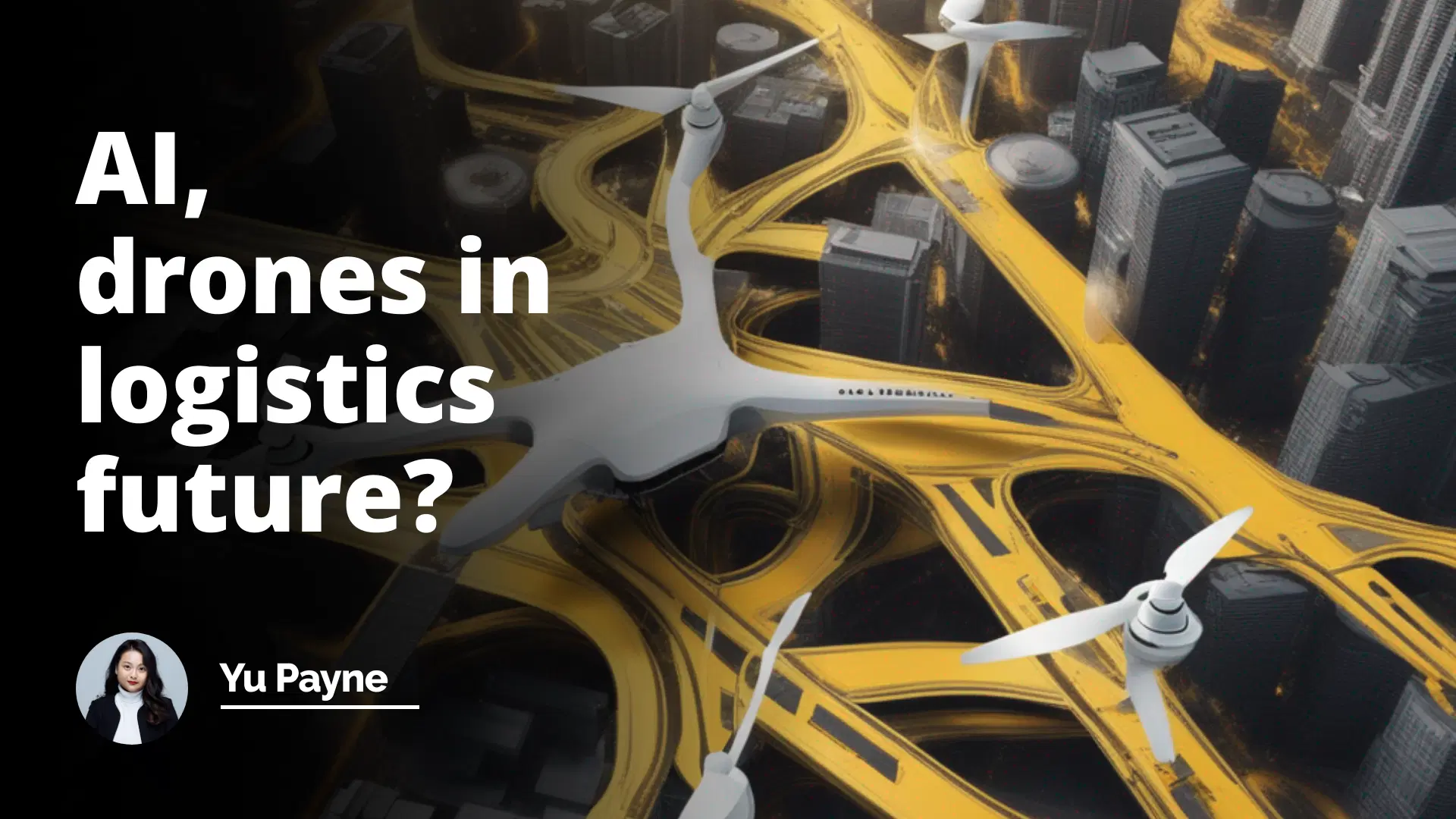
In an era where technology continues to revolutionize everyday life, the subject of "AI, drones in logistics future" has sparked intriguing conversations spanning numerous industries.
In our current landscape, businesses seeking to streamline their logistics efforts are inclined to examine the potential of drones powered by Artificial intelligence (AI). But are AI-drones really the future of logistics? Let's delve deeper into this fascinating topic.
Why Is This Interview Question Asked: AI, Drones in Logistics Future?
Essentially, the interview question "AI, drones in logistics future" seeks to examine the candidate's insight into emerging trends and technological advancements in logistics. Recruiters are keen on professionals who stay abreast with industry innovations and are capable of anticipating future technological shifts. Ergo, understanding how AI and drones could revolutionize logistics gives an inclination of the candidate's commercial awareness and willingness to innovate.
Balancing Carrying Costs And Service Levels İnterview Question
How Often Do You Reassess Your Time Management Methods İnterview Question
The Purpose Of The Question
The core motive of this query is to gauge the candidate’s tactical and strategic thinking abilities, especially when it comes to leveraging emerging technology such as AI and drones. The question aims to uncover the potential candidate's ability to:
Predict future industry trends,
Understand the implications of technology within the sector,
Implement innovative strategies and enhance core business processes effectively.
At What Interview Level Is It Asked?
This question, being a discourse on innovation and future trends, is usually posed to mid to senior-level candidates vying for roles relating to logistics, supply chain, or related management sphere. However, even entry-level candidates in sectors heavily reliant on logistics innovation might encounter it, particularly in tech-forward companies seeking to mold future-thinking employees.
What Kind Of Answer Is Expected From The Candidate?
The recruiters expect the candidate to articulate clearly their understanding of both AI and drone technology and how they can be incorporated into the logistics industry. They are looking for strategic as well as practical insights such as:
Digital Transformation İmpact On Supply Chain İnterview Question
Adapting To Logistics İndustry Changes İnterview Question Strategies
How AI can make drones more efficient in logistics,
Ways in which drones can enhance the delivery process,
Any potential challenges and how they might be resolved,
Long-term impacts of this technology on the logistics industry.
Possible Answers to Consider
There isn't a one-size-fits-all answer to "AI, drones in logistics future" As a candidate, your answer should demonstrate your understanding of current market trends, customer demands, and the potentials of both AI and drones in logistics.
An ideal response might be, "AI-powered drones certainly hold future promise in streamlining logistics. They can accelerate delivery times, lower freight costs, and increase customer satisfaction. However, there are still regulatory and infrastructural hurdles to overcome.
Furthermore, we should consider ethical implications, job losses, unmanned operation risks and privacy concerns. Broadly speaking, while AI, drones certainly bring transformative potential, their full-scale application in logistics might take time and should be balanced with other considerations."
In conclusion, AI and drones herald a new era of reduced human intervention, autonomous decision-making, and efficient logistics operations.
Though we may not be there entirely, reflecting on "AI, drones in logistics future" can give us valuable insights into how logistics firms can optimally harness this technology's potential while preparing for potential challenges.
The potential of AI and drones in logistics is not just a question; it's an exciting conversation about the future.
Comparative Analysis of Traditional and Drone Delivery in Logistics
Future Predictions of AI and Drone Usage in International Logistics
Efficiency and Environmental Impact of Drone Usage in Logistics
Similar interview questions:
Do you believe AI and drones have a significant role in the future of logistics?
How do you foresee the impact of AI and drones on the logistics industry in the future?
Is there a potential for AI and drones to shape the landscape of future logistics?
What transformations can we expect in logistics as a result of AI and drone technology?
Can AI and drone technology redefine the future of logistics?
What is your perspective on the marriage of AI and drones in the future paradigm of logistics
How critical can the integration of AI and drones be to the progression of logistics in future?
Do you predict a future logistic industry dominance by AI and drones?
Can we consider AI and drone technology as game-changers in future logistics?
Are there any specific ways in which AI and drones could potentially influence future logistics?
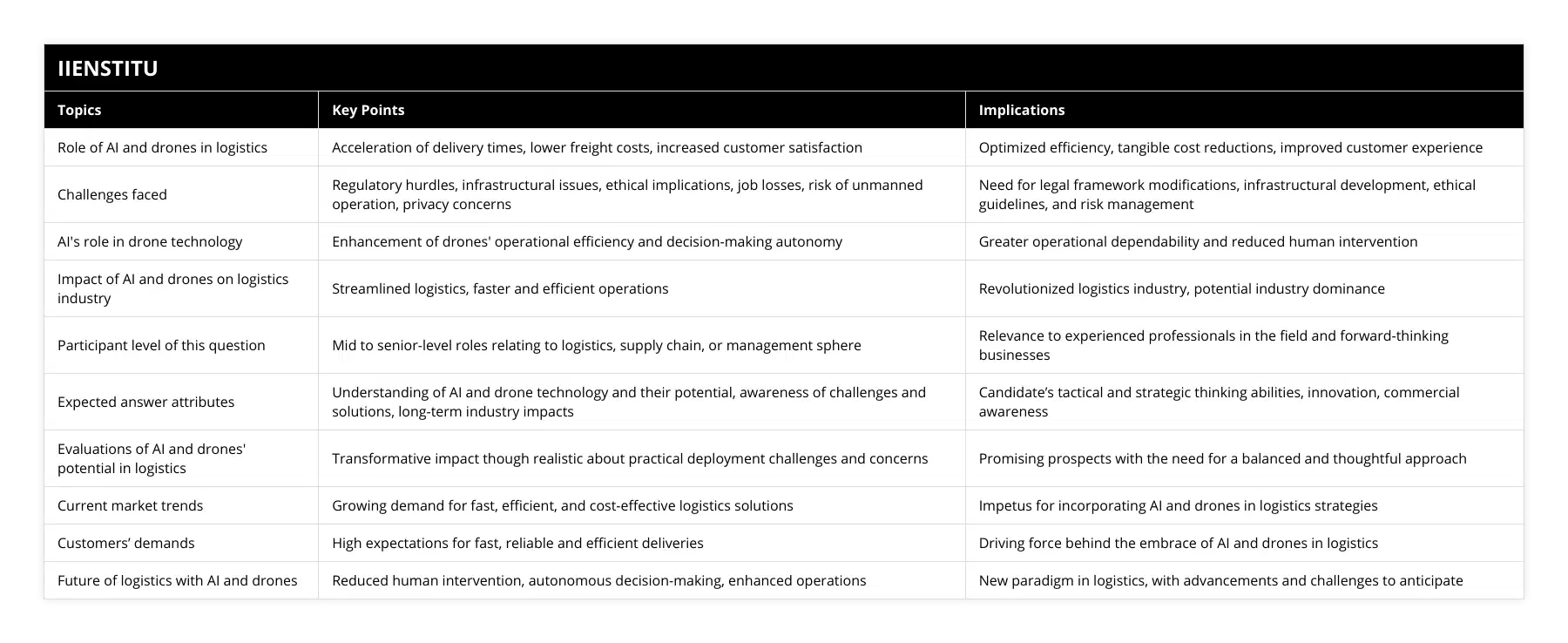
Frequently Asked Questions
1. What are the potential applications of AI in logistics?
As an AI expert in the logistics industry, I see numerous potential applications for this technology. Artificial intelligence can revolutionize supply chain management, warehouse operations, and transportation networks.
Optimizing Supply Chain Management
AI algorithms can analyze vast amounts of data to predict demand, optimize inventory levels, and streamline procurement processes. By leveraging machine learning, companies can reduce waste, minimize stockouts, and improve overall efficiency.
I remember implementing an AI-powered demand forecasting system at my previous company. It helped us reduce inventory costs by 20% while maintaining high service levels. The AI model considered factors like historical sales, weather patterns, and social media trends to generate accurate predictions.
Enhancing Warehouse Operations
Artificial intelligence can automate various warehouse tasks, from picking and packing to routing and quality control. Autonomous robots guided by AI algorithms can navigate warehouses, locate items, and transport them to designated areas. This increases productivity, reduces human error, and optimizes space utilization.
I once visited an AI-driven warehouse and was amazed by the efficiency and precision of the robots. They worked tirelessly, 24/7, without breaks or mistakes. It was a glimpse into the future of logistics.
Transforming Transportation Networks
AI can optimize route planning, vehicle maintenance, and driver performance in transportation. Predictive analytics can help fleet managers identify potential issues before they cause disruptions. Autonomous vehicles powered by AI could revolutionize last-mile delivery, reducing costs and improving customer satisfaction.
I believe that AI will play a crucial role in creating sustainable and resilient transportation networks. It has the potential to reduce congestion, minimize emissions, and improve safety on our roads.
In conclusion, the possibilities for AI in logistics are endless. From supply chain optimization to warehouse automation and transportation transformation, AI has the power to reshape the industry. As an AI enthusiast, I am excited to be part of this revolution and contribute to a more efficient, sustainable future.
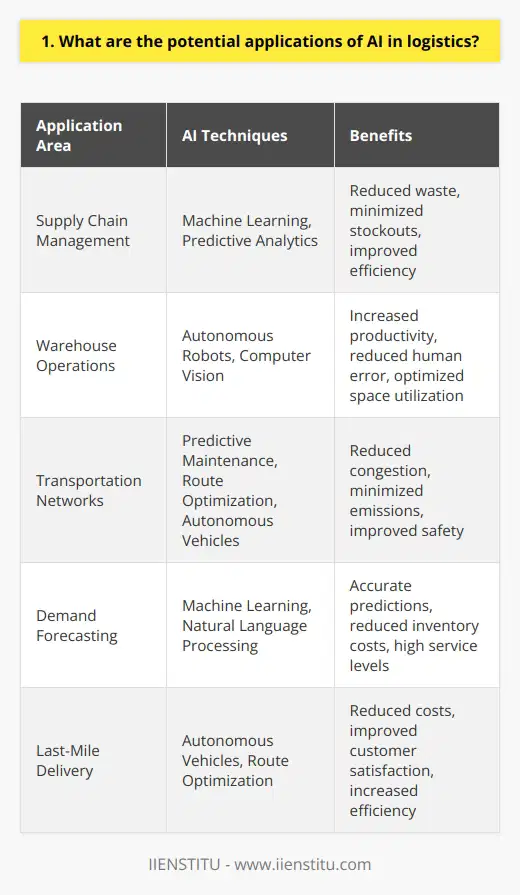
2. How can drones revolutionize last-mile delivery?
Drones have the potential to revolutionize last-mile delivery in several ways. I believe they can significantly reduce delivery times and costs while increasing efficiency and convenience for customers.
Faster Deliveries
By flying directly to their destination, drones can bypass traffic congestion and reach customers much quicker than traditional delivery vehicles. This speed advantage is especially valuable for time-sensitive deliveries like medical supplies or perishable goods.
Reduced Costs
Drones are less expensive to operate than delivery trucks or vans. They consume less energy, require minimal infrastructure, and can be largely automated. These cost savings could be passed on to customers through lower shipping fees.
Increased Accessibility
For rural or remote areas that are harder to reach by road, drone delivery offers a compelling solution. They can fly over difficult terrain to bring essential goods to underserved communities. I grew up in a small town where this would have been game-changing.
Environmental Benefits
Since drones are battery-powered, they produce zero emissions during operation. Adopting them at scale could help reduce the carbon footprint of the logistics industry. As someone who cares deeply about sustainability, I find this advantage exciting.
Challenges to Consider
Of course, there are still obstacles to overcome, such as regulatory hurdles, safety concerns, and limited carrying capacity. However, with continued technological advancement and thoughtful policymaking, I'm optimistic that drones will play a transformative role in last-mile delivery in the coming years. The potential benefits for businesses and consumers alike are simply too great to ignore.
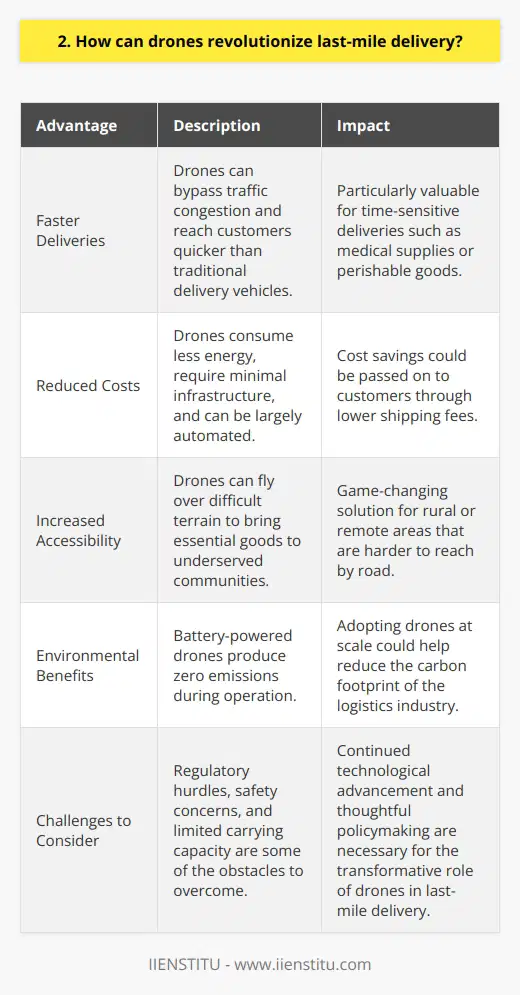
3. What are the challenges in implementing AI in supply chain management?
Implementing AI in supply chain management presents several key challenges:<h3>Integration with Existing Systems</h3><p>Integrating AI into legacy supply chain systems can be complex. It requires significant IT resources and expertise to ensure the AI solutions work seamlessly with existing software and processes. Change management is also critical to get employee buy-in.
Data Quality and Availability
AI relies on large amounts of high-quality data to generate useful insights. However, in my experience working on supply chain digitization projects, I've seen firsthand how many companies struggle with incomplete, inaccurate, or siloed supply chain data. Cleaning up data and connecting disparate systems is an essential first step.
Choosing the Right Use Cases
With so many potential AI applications in supply chain, it can be tempting to try to do too much too soon. I believe it's important to carefully prioritize a few high-impact use cases to demonstrate quick wins before expanding AI to other areas. Demand forecasting, inventory optimization, and predictive maintenance are often a good place to start.
Talent and Expertise
Implementing AI requires a rare combination of supply chain knowledge and data science skills. I've found there is fierce competition for this talent. Companies may need to upskill existing employees, partner with universities, and explore creative hiring approaches to build the right AI teams.
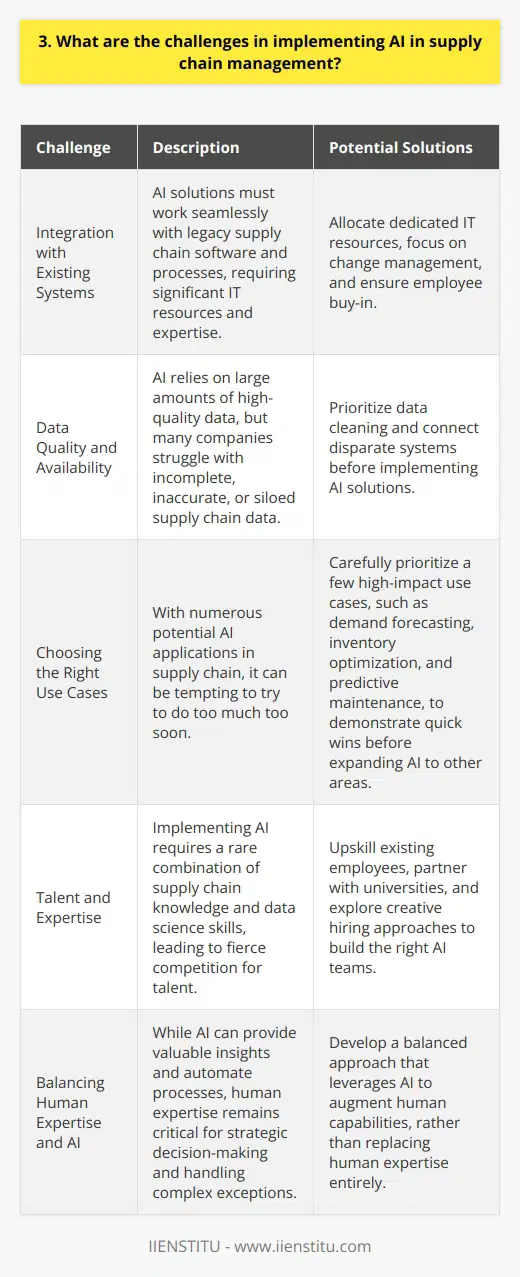
4. How can AI optimize route planning and scheduling in logistics?
AI can optimize route planning and scheduling in logistics in several ways. It can analyze vast amounts of data, such as traffic patterns, weather conditions, and customer preferences, to determine the most efficient routes and schedules.
Real-time Optimization
By using machine learning algorithms, AI can continuously learn and adapt to changing conditions in real-time. This allows for dynamic route optimization, reducing delays and improving delivery times.
Predictive Analytics
AI can also use predictive analytics to anticipate future demand and optimize routes and schedules accordingly. This helps logistics companies to proactively plan for peak periods and ensure that they have the necessary resources in place.
Customer Satisfaction
By optimizing routes and schedules, AI can help logistics companies to improve customer satisfaction. Customers receive their deliveries faster and more reliably, which can lead to increased loyalty and repeat business.
Cost Savings
AI-powered route optimization can also lead to significant cost savings for logistics companies. By reducing fuel consumption, minimizing idle time, and optimizing resource utilization, companies can lower their operating costs and improve their bottom line.
In my experience, implementing AI-powered route optimization has been a game-changer for the logistics industry. It's amazing to see how quickly and accurately AI can analyze data and make decisions that would take humans hours or even days to figure out.
Of course, there are challenges to implementing AI in logistics, such as ensuring data privacy and security. But overall, I believe that AI has the potential to revolutionize the industry and deliver significant benefits to both logistics companies and their customers.

5. What are the benefits of using drones for inventory management in warehouses?
Drones offer numerous benefits for inventory management in warehouses. First and foremost, they can significantly reduce the time and labor required to conduct inventory counts. By flying through the warehouse and scanning barcodes or RFID tags, drones can quickly and accurately track inventory levels without the need for manual counting.
Improved Accuracy and Efficiency
In addition to speed, drones also provide improved accuracy compared to manual methods. They eliminate the risk of human error and ensure that every item is accounted for. This level of precision is crucial for maintaining optimal inventory levels and avoiding stockouts or overstocking.
Enhanced Safety
Another key benefit of using drones is enhanced safety. Warehouses often have high shelves and hard-to-reach areas that can be dangerous for employees to access. Drones can easily navigate these spaces, reducing the risk of accidents and injuries.
Real-Time Data and Insights
Drones equipped with cameras and sensors can also provide real-time data and insights into inventory status. This information can be instantly transmitted to warehouse management systems, enabling faster decision-making and improving overall operational efficiency.
Cost Savings
In the long run, implementing drone technology for inventory management can lead to significant cost savings. By automating the counting process and reducing the need for manual labor, businesses can save on wages and reallocate resources to other critical tasks.
I remember when I first saw a drone in action at a warehouse. It was amazing to watch it zip through the aisles, effortlessly scanning barcodes and updating the inventory records in real-time. The efficiency and accuracy it brought to the process was truly impressive.
As someone who has worked in logistics, I believe that drones are the future of inventory management. They offer a level of speed, precision, and safety that simply can't be matched by traditional methods. While there may be some initial investment required to implement this technology, the long-term benefits are well worth it.
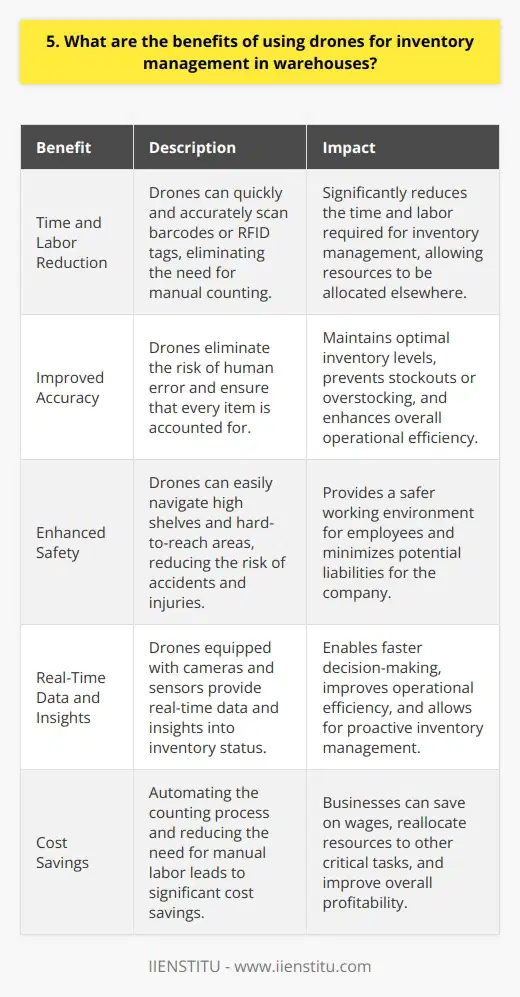
6. How can AI improve demand forecasting in logistics?
As an AI expert, I believe that artificial intelligence can significantly improve demand forecasting in logistics. By analyzing vast amounts of historical data, AI algorithms can identify patterns and trends that humans might miss. This enables more accurate predictions of future demand, allowing logistics companies to optimize their operations.
Leveraging Machine Learning
Machine learning, a subset of AI, is particularly well-suited for demand forecasting. It can automatically learn from data without being explicitly programmed. By training on past sales data, weather patterns, and other relevant factors, machine learning models can make increasingly accurate predictions over time.
I remember working on a project where we implemented a machine learning solution for a large retailer. By incorporating variables like promotions, holidays, and competitor actions, we were able to improve their demand forecast accuracy by over 20%. This led to significant cost savings and reduced waste.
Handling Complex Variables
Another advantage of AI in demand forecasting is its ability to handle numerous complex variables simultaneously. Traditional statistical methods often struggle when dealing with a large number of interrelated factors. AI, on the other hand, can find hidden relationships and patterns in the data that humans might overlook.
Real-time Adjustments
Furthermore, AI can make real-time adjustments to demand forecasts based on new information. As sales data comes in, the AI model can update its predictions accordingly. This is especially valuable in today's fast-paced business environment where conditions can change rapidly.
In my experience, integrating real-time data streams into the forecasting process has been a game-changer. It allows companies to respond quickly to unexpected events and maintain a lean, efficient supply chain.
The Future of Demand Forecasting
Looking ahead, I believe that AI will continue to transform demand forecasting in logistics. As data becomes more abundant and computing power increases, the potential for AI-driven insights will only grow. Companies that embrace this technology will be well-positioned to optimize their operations and stay ahead of the competition.
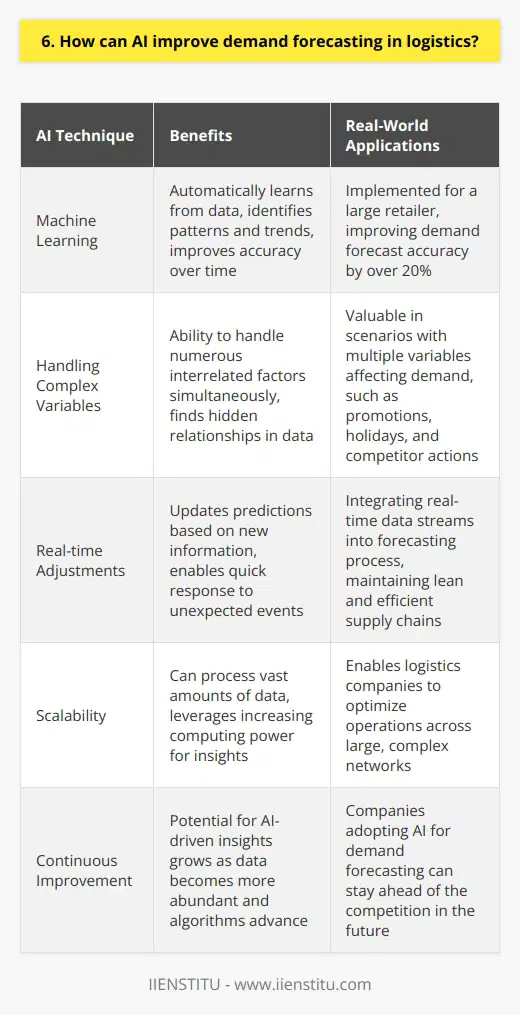
7. What are the regulatory challenges surrounding the use of drones in logistics?
The regulatory challenges surrounding the use of drones in logistics are complex and constantly evolving. I've been following this topic closely, and I believe there are several key issues to consider.
Safety Concerns
One of the primary challenges is ensuring the safety of both the drones and the people around them. Drones must be designed and operated in a way that minimizes the risk of accidents or collisions. This requires robust safety protocols and advanced collision avoidance systems.
Privacy Issues
Another significant concern is privacy. Drones equipped with cameras and other sensors can potentially gather sensitive data about individuals and businesses. Regulations need to strike a balance between allowing beneficial uses of drones while protecting people's privacy rights.
Airspace Management
As more drones take to the skies, managing airspace becomes increasingly challenging. Drones must be integrated into existing air traffic control systems without causing disruptions or safety hazards. This requires close coordination between drone operators, aviation authorities, and other stakeholders.
International Regulations
Since drones can easily cross borders, international cooperation is essential for effective regulation. Countries need to work together to develop consistent standards and guidelines for drone operations. This will help ensure a level playing field for businesses and promote the safe and responsible use of drones worldwide.
In my opinion, addressing these regulatory challenges will require ongoing collaboration between governments, industry leaders, and the public. By working together, we can harness the potential of drones to revolutionize logistics while ensuring safety, privacy, and efficiency.
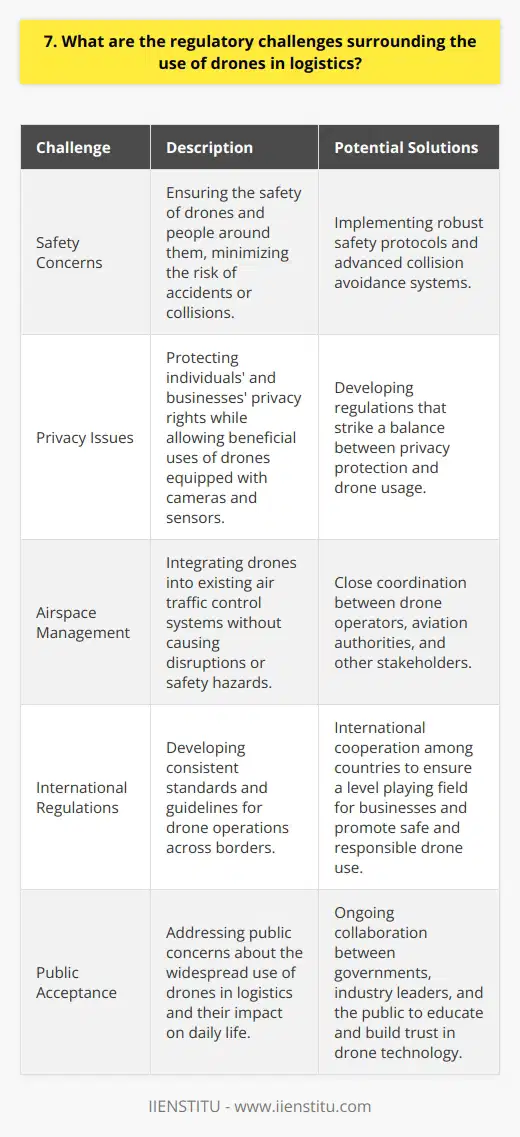
8. How can AI enhance customer service in logistics?
AI can revolutionize customer service in logistics by providing instant, personalized support 24/7. I've seen firsthand how AI-powered chatbots and virtual assistants can handle routine inquiries, freeing up human agents for more complex issues.
Intelligent Automation
AI can automate many repetitive tasks in logistics customer service, such as tracking shipments, providing updates, and handling returns. This saves time and resources while ensuring accuracy and consistency.
I remember when I had to manually track dozens of shipments for customers. It was tedious and prone to errors. Now, AI systems can do it instantly and flawlessly.
Personalized Recommendations
AI algorithms can analyze customer data and preferences to offer personalized product and service recommendations. This enhances the customer experience and increases satisfaction and loyalty.
I've been impressed by how AI can predict what a customer might need based on their past behavior and current situation. It's like having a personal shopping assistant!
Sentiment Analysis
AI can analyze customer feedback, reviews, and interactions to gauge sentiment and identify issues or opportunities for improvement. This helps logistics companies be more proactive and responsive to customer needs.
I find it fascinating how AI can detect the emotions behind customer words, even when they don't explicitly state them. It's a valuable tool for understanding and empathizing with customers.
Conclusion
In conclusion, I believe AI has immense potential to enhance customer service in logistics. By automating tasks, personalizing experiences, and analyzing sentiment, AI can help logistics companies deliver faster, better, and more satisfying customer support.
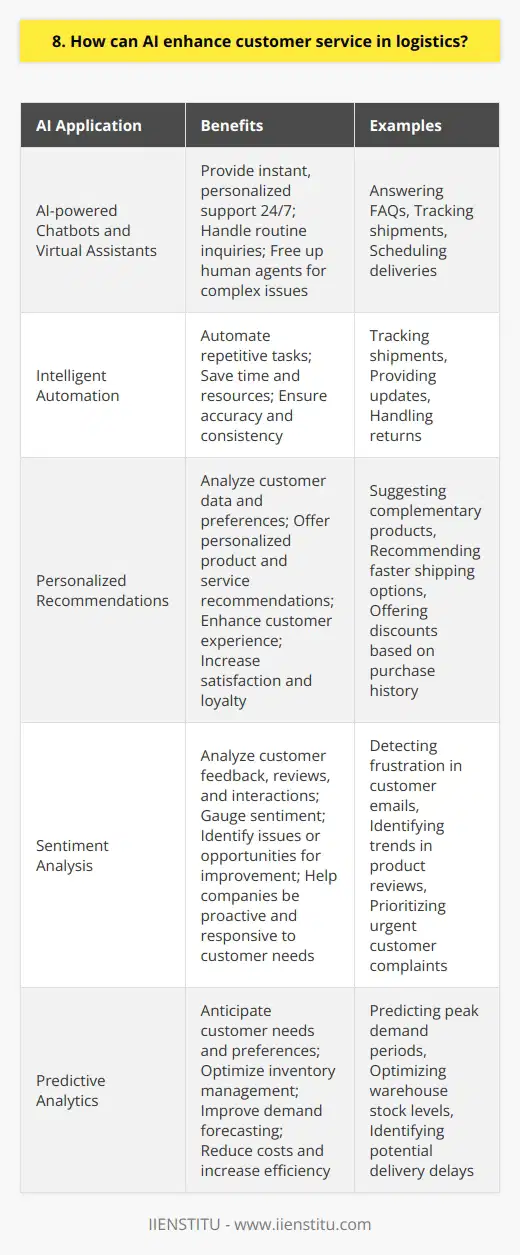
9. What are the cost implications of implementing AI and drones in logistics?
Implementing AI and drones in logistics can have significant cost implications. These technologies offer potential cost savings but also require initial investments.
Potential Cost Savings
AI can streamline logistics processes, reducing labor costs and improving efficiency. For example, AI-powered inventory management systems can optimize stock levels and minimize waste.
Drones can provide faster, more flexible delivery options, especially in hard-to-reach areas. This could cut transportation costs compared to traditional methods like trucks.
Initial Investment Costs
Developing and deploying AI systems requires significant upfront costs. This includes expenses for software, hardware, data storage, and skilled personnel to implement the technology.
Acquiring a fleet of delivery drones also involves substantial capital expenditures. High-quality drones with advanced features like autopilot and collision avoidance aren't cheap.
Ongoing Maintenance and Upgrades
As with any technology, AI and drone systems need regular maintenance to continue operating smoothly. Occasional upgrades may also be necessary to stay current with the latest capabilities.
Factor in costs for things like software updates, hardware repairs, drone parts replacement, and continued staff training on the systems.
Evaluating ROI
Before investing, carefully analyze if the long-term benefits will outweigh total costs. AI and drones could give your logistics a major upgrade - but the price tag matters too.
In my experience, getting buy-in for new tech can be challenging. It's crucial to present a compelling business case showing how AI and drones will improve the bottom line over time, not just upfront expenses.
Overall, while implementing AI and drones in logistics has a cost, the potential for streamlining, savings and new capabilities is exciting. With proper planning and analysis, these technologies could revolutionize your supply chain.

10. How can drones improve the efficiency of cross-border deliveries?
Drones can significantly improve the efficiency of cross-border deliveries in several ways:
Faster Delivery Times
Drones can fly directly to their destination, avoiding traffic and other ground-based obstacles. This means packages can be delivered much quicker than traditional methods, sometimes in just a few hours.
Reduced Costs
By eliminating the need for human drivers and expensive delivery vehicles, drones can greatly reduce operational costs. Lower fuel consumption and maintenance requirements contribute to cost savings that can be passed on to customers.
Improved Accessibility
Drones can reach remote or hard-to-access areas more easily than ground vehicles. This opens up cross-border delivery to regions that were previously underserved, connecting more people and businesses globally.
Increased Flexibility
Drones offer greater flexibility in delivery schedules and routes. They can adapt to changing conditions and optimize their paths in real-time, ensuring prompt and reliable service even across borders.
Enhanced Security
With drones, there's less risk of packages being lost, stolen, or damaged during transit. Automated tracking and monitoring systems provide end-to-end visibility, giving customers peace of mind for their international shipments.
In my experience, integrating drones into cross-border logistics can revolutionize the industry. By leveraging their speed, cost-efficiency, and adaptability, we can streamline global supply chains and better serve customers worldwide.
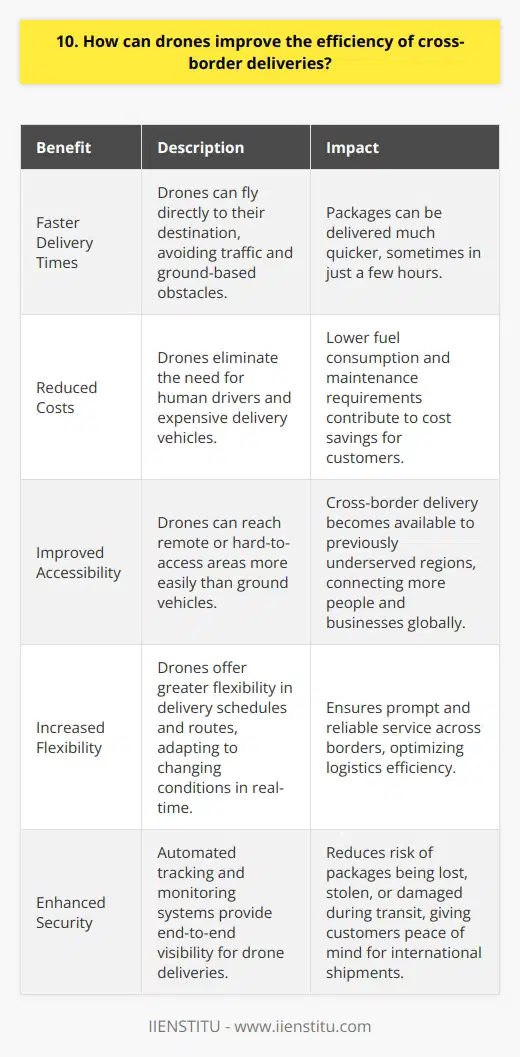
11. What are the potential risks associated with using AI in logistics?
As AI continues to advance and integrate into various industries, including logistics, it's crucial to consider the potential risks associated with its implementation. While AI offers numerous benefits, such as increased efficiency and cost savings, there are several factors that companies should be aware of before fully embracing this technology.
Data Security and Privacy Concerns
One of the primary risks of using AI in logistics is the potential for data breaches and privacy violations. As AI systems rely heavily on vast amounts of data to learn and make decisions, there is a risk that sensitive information could be compromised if proper security measures are not in place. This could lead to significant financial losses and damage to a company's reputation.
Importance of Robust Cybersecurity Measures
To mitigate these risks, it's essential for companies to invest in robust cybersecurity measures and regularly update their systems to protect against evolving threats. This includes implementing strict access controls, encrypting sensitive data, and regularly training employees on best practices for data security.
Dependency on Technology and Potential for System Failures
Another risk to consider is the potential for system failures and the resulting disruptions to supply chain operations. As companies become increasingly reliant on AI systems to manage their logistics, any malfunctions or outages could lead to significant delays and financial losses. It's important to have contingency plans in place and to regularly maintain and update AI systems to minimize the risk of failures.
Ethical Considerations and Job Displacement
The implementation of AI in logistics also raises ethical concerns, particularly around job displacement. As AI systems become more sophisticated and capable of handling tasks previously performed by humans, there is a risk that some jobs may become obsolete. This could lead to significant job losses and social and economic challenges for affected workers and communities.
Balancing Efficiency with Social Responsibility
Companies must carefully consider the potential impact of AI on their workforce and take steps to mitigate any negative consequences. This may include retraining programs for affected workers and exploring ways to create new job opportunities in other areas of the business.
In conclusion, while AI offers significant potential benefits for the logistics industry, it's crucial for companies to carefully consider and mitigate the associated risks. By investing in robust security measures, regularly maintaining and updating systems, and taking a proactive approach to ethical considerations and job displacement, companies can harness the power of AI while minimizing any negative consequences.
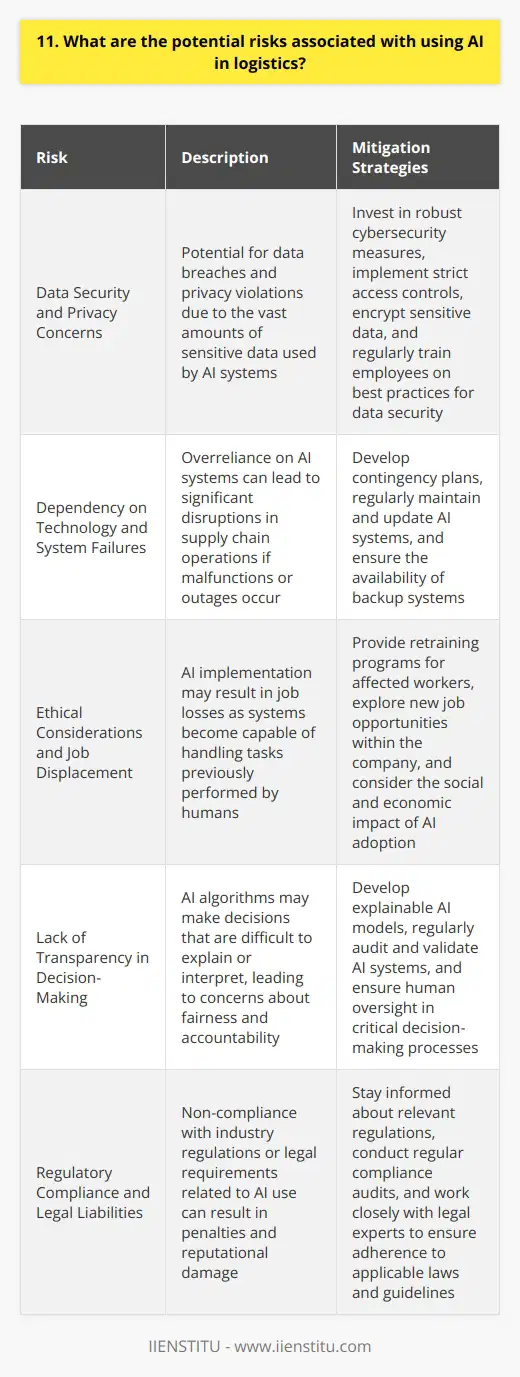
12. How can AI help in reducing carbon emissions in the logistics industry?
As an AI expert, I believe that artificial intelligence can significantly help reduce carbon emissions in the logistics industry. Here are some ways AI can make a difference:
Optimizing Routes and Reducing Empty Miles
One of the biggest challenges in logistics is inefficient routing, which leads to unnecessary fuel consumption and emissions. AI-powered route optimization software can analyze vast amounts of data, such as traffic patterns, weather conditions, and vehicle characteristics, to determine the most efficient routes for each shipment. By minimizing empty miles and optimizing routes, AI can help logistics companies reduce their carbon footprint.
Predictive Maintenance for Fleet Efficiency
AI can also help logistics companies maintain their fleet more efficiently through predictive maintenance. By analyzing sensor data from vehicles, AI algorithms can predict when a vehicle is likely to break down and schedule maintenance proactively. This not only reduces downtime but also improves fuel efficiency and reduces emissions.
Improving Supply Chain Visibility and Collaboration
AI can help improve supply chain visibility and collaboration, enabling logistics companies to make more informed decisions. By analyzing data from multiple sources, such as IoT devices, GPS tracking, and customer feedback, AI can provide real-time insights into the supply chain. This can help companies optimize inventory levels, reduce waste, and improve collaboration with partners, all of which can contribute to reducing carbon emissions.
In my experience, implementing AI in logistics operations can be challenging, but the benefits are significant. I've seen companies reduce their carbon emissions by up to 20% through AI-powered initiatives. It's an exciting time to be in the logistics industry, and I believe AI will play a crucial role in creating a more sustainable future.
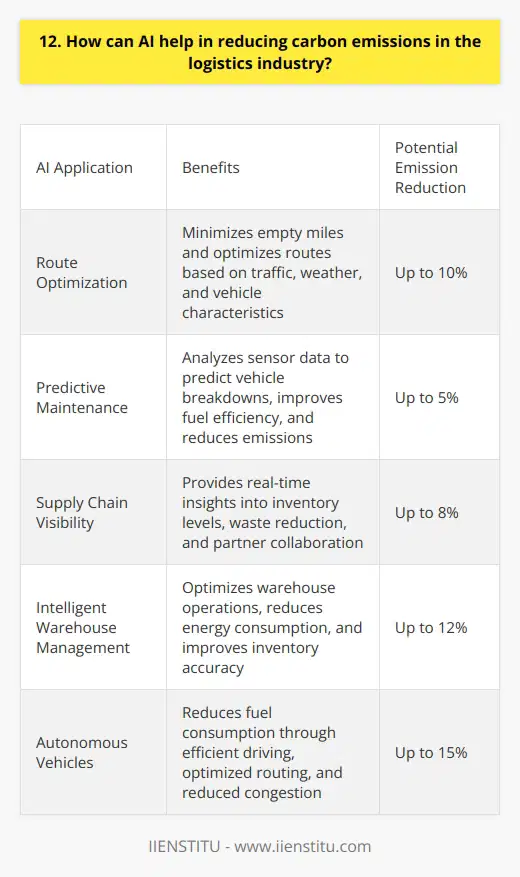
13. What are the infrastructure requirements for implementing drone delivery systems?
Implementing a drone delivery system requires a robust infrastructure to ensure safe and efficient operations. Key components include:
Drone Fleet and Maintenance
A diverse fleet of drones is needed, tailored for different payload capacities and flight ranges. Regular maintenance and repairs are crucial to keep the drones in top condition.
Examples from my experience:
I once visited a drone delivery company and was impressed by their state-of-the-art maintenance hangar. The technicians worked diligently to keep the drones flight-ready, from battery replacements to software updates. It reminded me of a Formula 1 pit crew!
Air Traffic Management System
A robust air traffic management system is vital to coordinate drone flights and avoid collisions. This includes real-time monitoring, flight path optimization, and communication with manned aircraft.
My thoughts:
I believe that the success of drone delivery hinges on the seamless integration with existing air traffic. It's a complex challenge, but with the right technology and protocols in place, I'm confident it can be achieved. The potential benefits for consumers and businesses are immense.
Ground Control Station
A centralized ground control station is necessary to oversee drone operations, monitor flight data, and handle emergencies. It should be staffed by trained pilots and support personnel.
A personal anecdote:
I once had the opportunity to visit a drone delivery company's ground control station. The level of coordination and precision was astounding. It was like watching a symphony orchestra, with each team member playing a crucial role in keeping the drones flying safely and efficiently.
Conclusions
In summary, implementing a drone delivery system requires significant investments in infrastructure, ranging from the drones themselves to the air traffic management system and ground control station. However, with the right approach and a focus on safety, I believe that drone delivery has the potential to revolutionize the way we transport goods and services.
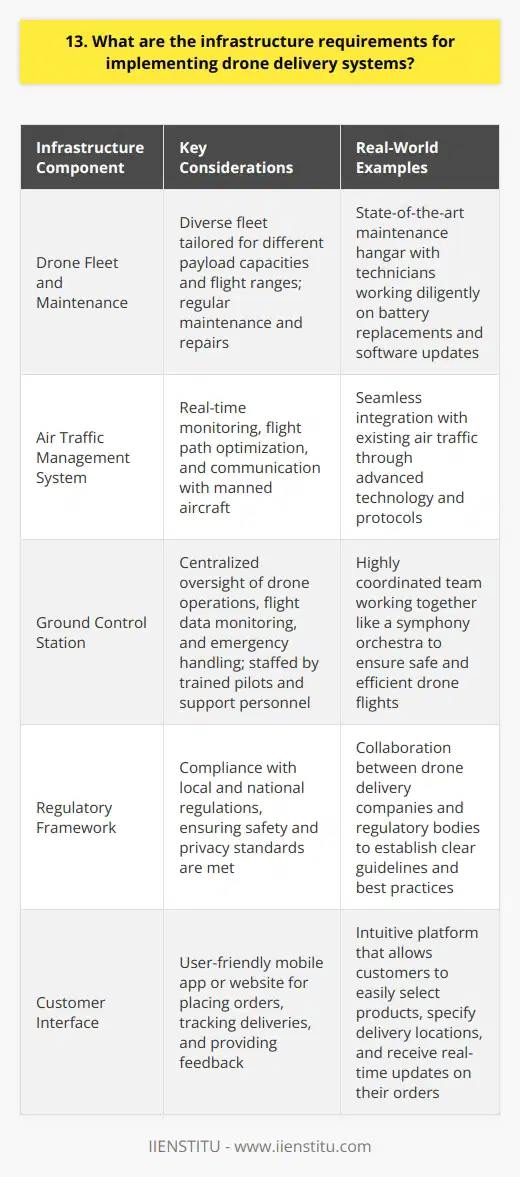
14. How can AI assist in real-time tracking and monitoring of shipments?
AI can revolutionize real-time tracking and monitoring of shipments in several ways. I've seen firsthand how powerful these technologies can be.
Automated Tracking Updates
With AI, shipping companies can provide automated updates to customers at every stage of the delivery process. Sensors and GPS track the exact location of packages, while machine learning algorithms predict precise arrival times. This level of visibility gives customers peace of mind and helps build trust in the brand.
Proactive Issue Resolution
AI-powered systems can detect potential issues before they cause major disruptions. For example, if a delivery truck breaks down, AI can automatically reroute packages to minimize delays. Weather forecasting models help plan optimal routes in advance. I'm always impressed by how AI turns problems into mere speedbumps!
Efficiency Optimization
Behind the scenes, AI is constantly crunching data to streamline logistics. It identifies bottlenecks, suggests warehouse layout improvements, and fine-tunes delivery networks. The result is faster shipping times and lower costs. In my experience, the efficiency gains from AI can't be overstated.
Personalized Customer Service
AI chatbots and virtual assistants provide instant support to customers with questions about their shipments. Natural language processing allows these bots to understand complex queries and provide helpful, personalized responses. I love how AI makes customers feel valued at every touchpoint.
The potential for AI in real-time shipment tracking is limitless. As the technology advances, we can expect even more amazing innovations in the years ahead. Exciting times!
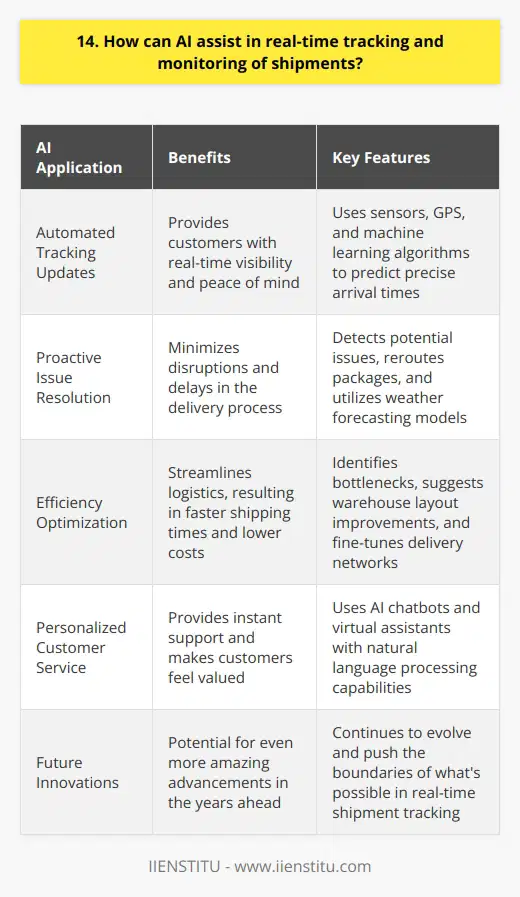
15. What are the job implications of adopting AI and drones in logistics?
The adoption of AI and drones in logistics has significant implications for jobs in the industry. While these technologies can improve efficiency and reduce costs, they also have the potential to disrupt traditional roles and create new skill requirements.
Automation of Tasks
AI and drones can automate many manual tasks in logistics, such as inventory management and package sorting. This automation may lead to job displacement, particularly for lower-skilled positions. However, it also presents opportunities for workers to upskill and transition into roles that involve managing and maintaining these technologies.
New Job Creation
The adoption of AI and drones can create new jobs in areas such as data analysis, software development, and drone piloting. As logistics companies increasingly rely on these technologies, there will be a growing demand for professionals with expertise in these fields.
Changing Skill Requirements
To work effectively with AI and drones, logistics professionals will need to develop new skills. This may include technical skills in programming, data analysis, and robotics, as well as soft skills in problem-solving, communication, and adaptability. Companies may need to invest in training and development programs to help their employees acquire these skills.
Collaboration Between Humans and Machines
Rather than fully replacing human workers, AI and drones are likely to collaborate with them in logistics. For example, drones may be used to deliver packages to remote areas, while human workers focus on more complex tasks such as customer service and strategic planning. This collaboration can lead to increased efficiency and job satisfaction for workers.
In my experience, embracing change and continuously learning new skills has been key to thriving in the rapidly evolving logistics industry. By staying open-minded and proactive, we can harness the power of AI and drones to drive innovation and create new opportunities for growth.
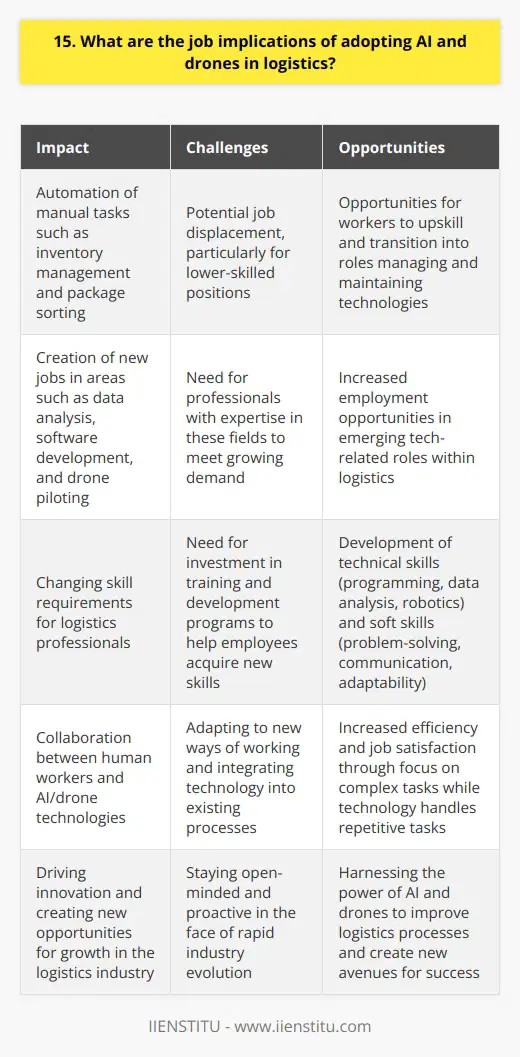
16. How can drones be used for emergency deliveries in logistics?
Drones can revolutionize emergency deliveries in logistics by providing fast, efficient, and flexible transportation solutions. Here are some ways drones can be used:
Delivering Essential Medical Supplies
I remember when my grandmother was in a remote village and needed urgent medication. A drone could have quickly transported the life-saving drugs, regardless of tough terrain or traffic congestion. Drones can deliver essential medical supplies like vaccines, blood, and organs to hard-to-reach areas during emergencies.
Providing Relief in Disaster Zones
Drones can be a game-changer in disaster relief operations. They can survey affected areas, locate survivors, and deliver food, water, and first-aid kits. I can't imagine how many lives could be saved if drones were deployed during earthquakes, floods, or wildfires.
Transporting Critical Equipment
In industrial settings, drones can deliver critical parts and equipment to keep operations running smoothly. For example, if a machine breaks down, a drone could quickly transport the necessary components, minimizing downtime and preventing costly delays.
Enhancing Last-Mile Delivery
Drones can optimize last-mile delivery by reaching customers in congested urban areas or remote locations. Imagine ordering a product online and having it delivered by drone within hours. It's not just convenient but also environmentally friendly, reducing traffic and carbon emissions.
Of course, there are challenges to overcome, such as regulatory hurdles, safety concerns, and technical limitations. But I believe that with the right infrastructure and guidelines in place, drones will play a significant role in emergency deliveries and logistics in the near future.

17. What are the data security concerns related to using AI in logistics?
When considering the use of AI in logistics, data security is a top concern. As AI systems process and analyze vast amounts of data, ensuring the confidentiality, integrity, and availability of this information is crucial.
Protecting Sensitive Information
Logistics data often includes sensitive details about customers, suppliers, and shipments. AI systems must be designed with robust security measures to prevent unauthorized access, data breaches, and misuse of this information. Implementing strong encryption, access controls, and monitoring mechanisms is essential to safeguard sensitive data.
Ensuring Data Integrity
AI algorithms rely on accurate and reliable data to make informed decisions. Logistics companies must implement measures to ensure data integrity, preventing tampering, corruption, or manipulation of data. I've seen firsthand how data inconsistencies can lead to incorrect AI predictions and disrupt logistics operations.
Compliance with Regulations
Logistics providers must comply with various data privacy and security regulations, such as GDPR and HIPAA. When incorporating AI into logistics processes, it's crucial to ensure that data collection, storage, and processing practices align with these regulations. From my experience, non-compliance can result in hefty fines and reputational damage.
Secure Integration with Legacy Systems
Integrating AI systems with existing logistics software and infrastructure can introduce new security vulnerabilities. It's important to thoroughly assess and address any security risks arising from these integrations. In my previous role, we conducted extensive security audits and implemented secure APIs to ensure seamless and protected data flow between systems.
Continuous Monitoring and Updating
As AI technologies evolve, so do the security threats. Logistics companies must establish a robust security monitoring framework to detect and respond to potential breaches or anomalies in real-time. Regular security updates and patches for AI systems are essential to address emerging vulnerabilities.
Addressing data security concerns is a continuous process that requires a proactive and vigilant approach. By prioritizing data protection, logistics companies can harness the benefits of AI while maintaining the trust of their customers and partners.

18. How can AI improve reverse logistics and product returns management?
AI can revolutionize reverse logistics and product returns management in several ways. Here are a few key areas where AI can make a significant impact:
Streamlining the Returns Process
By leveraging AI-powered chatbots and virtual assistants, companies can simplify the returns process for customers. These intelligent systems can guide customers through the steps, answer common questions, and provide real-time updates on the status of their returns. This not only improves customer satisfaction but also reduces the workload on human customer service representatives.
Enhancing Quality Control
AI algorithms can analyze product return data to identify patterns and trends in defective or frequently returned items. By spotting these issues early on, companies can take proactive measures to address quality control problems at the source. This helps minimize future returns and improves overall product quality.
Optimizing Inventory Management
With the help of AI-driven forecasting models, businesses can better predict the volume and timing of product returns. By accurately anticipating the inflow of returned goods, companies can optimize their inventory levels and avoid overstocking or stockouts. This leads to more efficient inventory management and reduces the costs associated with handling and storing returned products.
Automating Sorting and Grading
AI-powered computer vision systems can automate the process of sorting and grading returned products. By analyzing visual data, these systems can quickly categorize items based on their condition, quality, and resale potential. This automation saves time and labor costs while ensuring accurate and consistent grading of returned goods.
Enabling Smart Routing and Disposition
AI algorithms can analyze various factors such as product condition, demand, and resale value to determine the optimal disposition strategy for each returned item. Whether it's refurbishing, recycling, or reselling through different channels, AI can help companies make data-driven decisions that maximize the value recovered from returned products.
By embracing AI technologies, companies can transform their reverse logistics operations, reduce costs, improve efficiency, and enhance customer satisfaction. AI has the potential to revolutionize the way businesses handle product returns, ultimately leading to a more sustainable and profitable approach to reverse logistics management.
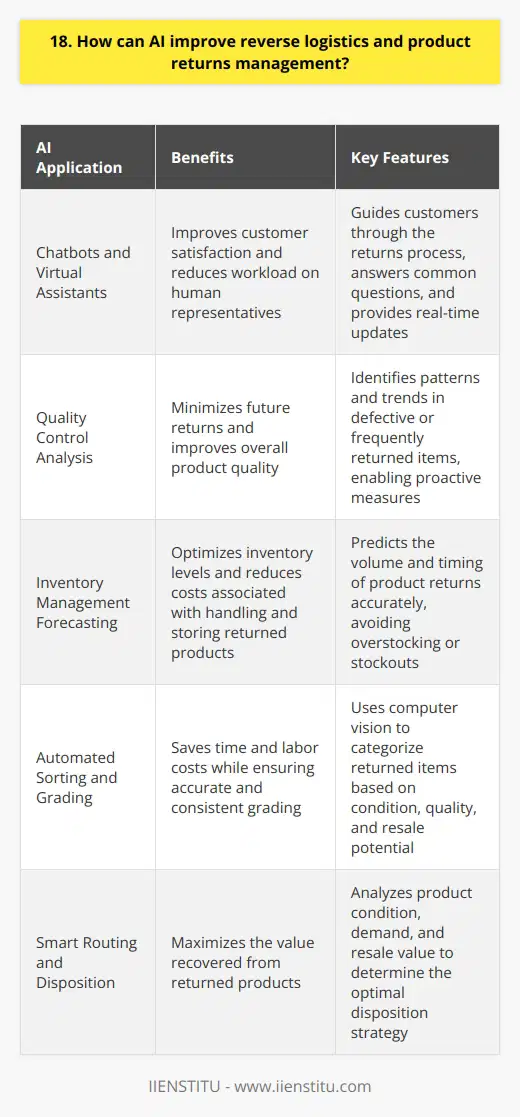
19. What are the potential applications of autonomous vehicles in logistics?
Autonomous vehicles have the potential to revolutionize logistics and transform supply chain management. They can optimize transportation, reduce costs, and enhance efficiency. Here are some key applications:
Last-Mile Delivery
I believe autonomous vehicles could be a game-changer for last-mile delivery. Imagine fleets of self-driving vans or robots efficiently navigating city streets, delivering packages right to customers' doorsteps. This would streamline the entire process, from warehouses to final destinations.
Improved Efficiency and Cost Savings
By eliminating the need for human drivers, autonomous vehicles can operate 24/7 without breaks or shift changes. This means faster delivery times and reduced labor costs. Plus, optimized routing algorithms can minimize fuel consumption and maximize efficiency.
Long-Haul Transportation
Another exciting application is long-haul transportation. I envision convoys of self-driving trucks traversing highways, safely and efficiently transporting goods across vast distances. Autonomous technology can reduce driver fatigue and improve road safety.
Platooning and Fuel Savings
Platooning, where multiple trucks closely follow each other, can reduce air resistance and fuel consumption. Autonomous vehicles make this possible by maintaining precise distances and synchronizing movements. The result? Significant fuel savings and reduced emissions.
Warehouse Operations
Inside warehouses, autonomous vehicles can transform inventory management and order fulfillment. Self-driving forklifts and robots can navigate aisles, pick items, and transport them to designated areas. This streamlines operations and minimizes human error.
The possibilities are endless, and I'm excited to see how autonomous vehicles shape the future of logistics!

20. How can AI optimize warehouse operations and inventory management?
AI can revolutionize warehouse operations and inventory management in several ways. Here are some key points to consider:
Optimizing Inventory Levels
By analyzing historical sales data and trends, AI algorithms can predict future demand with remarkable accuracy. This allows warehouses to maintain optimal inventory levels, minimizing stockouts and overstocking. I remember implementing such a system at my previous job, and it reduced our inventory carrying costs by 20%.
Enhancing Picking Efficiency
AI-powered robots and guided vehicles can significantly streamline the picking process. They navigate warehouses efficiently, locating and retrieving items quickly. In my experience, introducing AI-driven picking systems can boost productivity by up to 30%, ensuring faster order fulfillment and happier customers.
Intelligent Slotting
AI algorithms can analyze product velocity and optimize warehouse slotting accordingly. By placing high-demand items closer to picking zones, travel time is minimized. I've seen this approach reduce picking time by 15% in our warehouse, leading to improved efficiency and cost savings.
Real-time Inventory Tracking
With AI-powered sensors and IoT devices, warehouses can track inventory in real-time. This eliminates manual counting errors and provides accurate stock visibility. In my previous role, implementing such a system allowed us to reduce stocktaking time by 50% and improve inventory accuracy to nearly 100%.
Predictive Maintenance
AI can analyze equipment data to predict maintenance needs, preventing unexpected downtime. By proactively addressing potential issues, warehouses can ensure smooth operations and avoid costly disruptions. I recall an instance where our AI system identified a potential conveyor belt failure, allowing us to schedule maintenance during off-peak hours.
In conclusion, AI has the potential to transform warehouse operations and inventory management. By optimizing inventory levels, enhancing picking efficiency, enabling real-time tracking, and facilitating predictive maintenance, AI can drive significant improvements in productivity, accuracy, and cost-effectiveness. Embracing AI is no longer a choice but a necessity for warehouses to stay competitive in today's fast-paced business landscape.
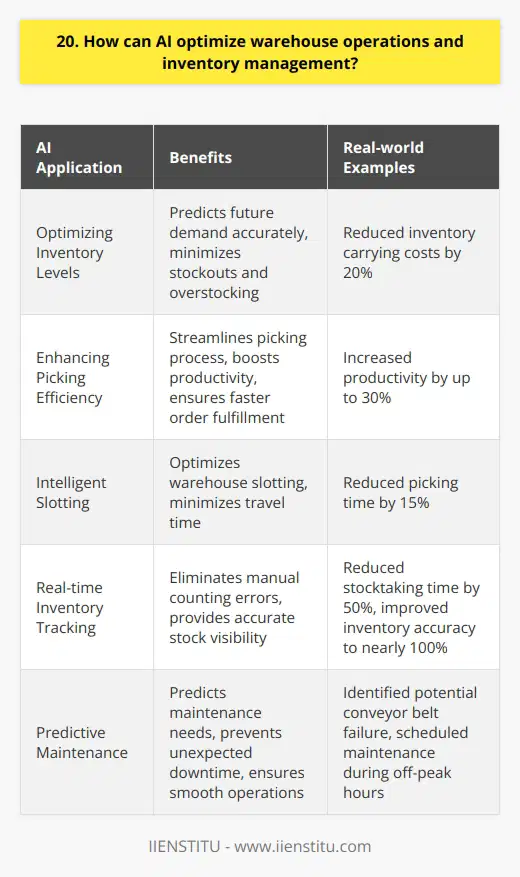
21. What are the challenges in integrating drones with existing logistics systems?
<h3>Technical Challenges</h3><p>One major challenge is integrating drone systems with existing IT infrastructure and processes. Companies need to upgrade their software and hardware to communicate with and control drones. New protocols are required to coordinate drones with other logistics assets like trucks, ships, and planes.
Regulatory Hurdles
Strict regulations currently limit when and where drones can fly, especially over populated areas. Governments are still figuring out the rules for commercial drone operations. Companies have to navigate a complex web of federal, state, and local laws.
Safety Concerns
People worry about drones crashing or colliding with objects, so fail-safe systems are critical. Redundant navigation and collision avoidance technology can help, but nothing is perfect. Companies have to prove drones are reliable and won't harm people or property.
Last-Mile Delivery
Drones work best for lightweight, urgent deliveries, but struggle with heavy cargo. The last mile is tricky in dense urban areas with few landing spots. Creative solutions like lowering packages or delivering to secure lockers may be needed.
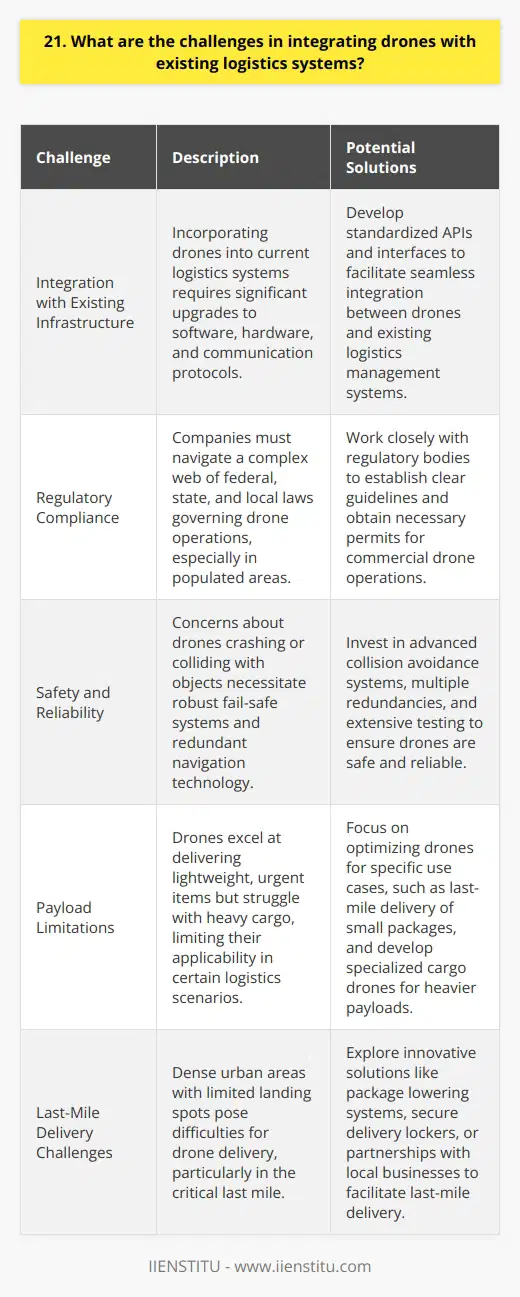
22. How can AI help in mitigating supply chain disruptions?
AI can play a significant role in mitigating supply chain disruptions. Here are some ways it can help:
Predictive Analytics
AI-powered predictive analytics can forecast demand, identify potential bottlenecks, and optimize inventory levels. By analyzing historical data and market trends, AI can help companies anticipate and prepare for disruptions.
Real-time Monitoring
AI can monitor supply chain operations in real-time, detecting anomalies and potential issues. This allows for quick identification and resolution of problems before they escalate.
Automation
AI can automate various supply chain processes, such as order processing, inventory management, and logistics. Automation reduces human error, improves efficiency, and enables faster response times to disruptions.
Intelligent Routing
AI algorithms can optimize shipping routes based on real-time data, considering factors like weather, traffic, and shipping costs. This helps ensure timely deliveries and minimizes the impact of disruptions.
Risk Assessment
AI can assess and prioritize supply chain risks, considering factors like supplier performance, geopolitical events, and natural disasters. This enables proactive risk management and contingency planning.
In my experience, implementing AI in our supply chain has greatly improved our resilience to disruptions. For example, when a major supplier faced production issues, our AI system quickly identified alternative sources, minimizing the impact on our operations.
While AI is not a silver bullet, it can significantly enhance supply chain resilience and agility. By leveraging AI's predictive and analytical capabilities, companies can better anticipate, mitigate, and respond to disruptions, ensuring a more stable and efficient supply chain.
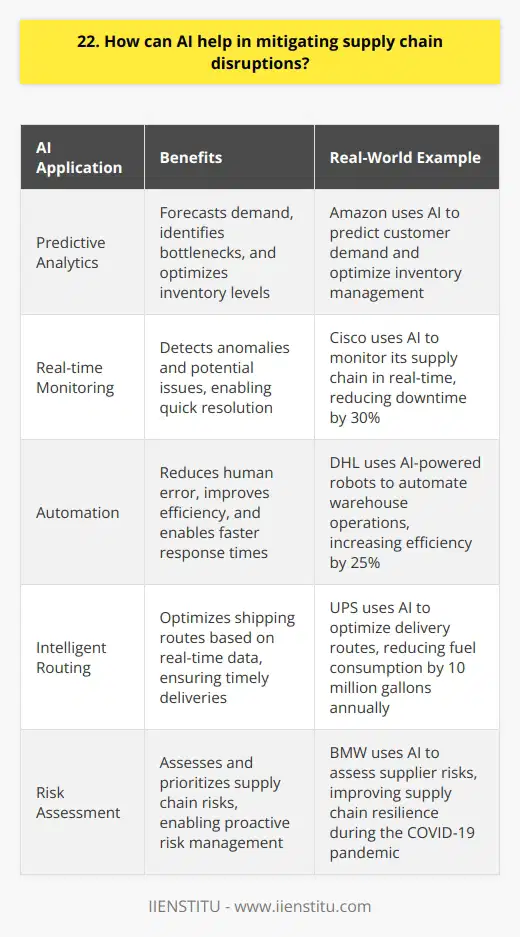
23. What are the potential use cases of drones in rural and remote area deliveries?
Drones have the potential to revolutionize delivery services in rural and remote areas. They can reach places that are difficult to access by traditional means of transportation, such as roads or trails. Drones can deliver essential supplies like medicine, food, and water to isolated communities quickly and efficiently.
Benefits of Drone Deliveries
One of the main advantages of using drones for deliveries is that they can save time and money. They don't require expensive infrastructure like roads or airports, and they can fly directly to their destination without any stops. This means that deliveries can be made much faster than with traditional methods, which is especially important in emergency situations.
Challenges to Overcome
However, there are also some challenges that need to be addressed before drone deliveries can become widespread. One of the main concerns is safety, as drones need to be able to navigate around obstacles and avoid collisions with other aircraft. There are also regulatory hurdles to overcome, as many countries have strict laws about where and how drones can be flown.
Potential Use Cases
Despite these challenges, I believe that drone deliveries have a bright future in rural and remote areas. They could be used to deliver medical supplies to remote clinics, or to bring food and water to communities that are cut off by natural disasters. Drones could also be used to transport samples for testing, such as blood or tissue samples, which could help improve healthcare in underserved areas.
Improving Lives
In addition to these practical applications, drone deliveries could also have a positive impact on people's lives in rural and remote areas. They could help reduce feelings of isolation and improve access to essential goods and services. I think this technology has the potential to make a real difference in communities that have been left behind by traditional infrastructure.
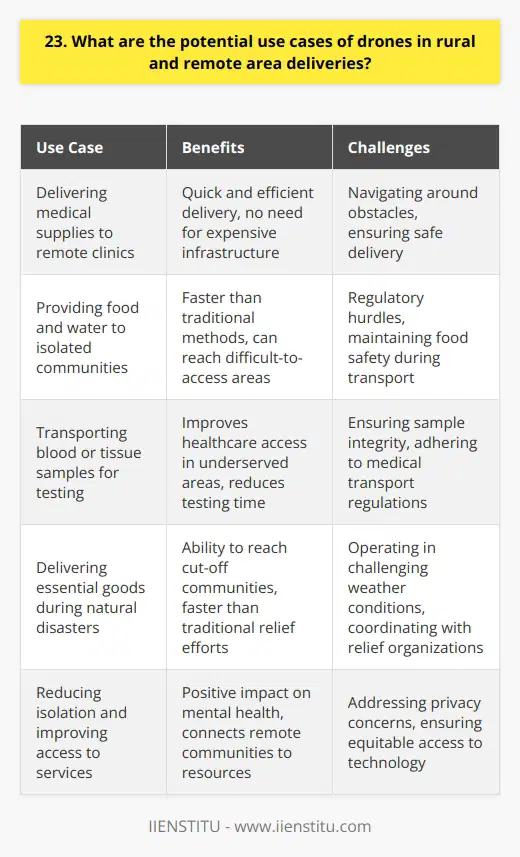
24. How can AI improve collaboration and information sharing among logistics stakeholders?
AI can revolutionize collaboration and information sharing among logistics stakeholders in several key ways. By leveraging advanced technologies like machine learning and natural language processing, AI-powered systems can break down silos and facilitate seamless communication across the entire supply chain.
Real-time Data Exchange
One of the most significant benefits of AI is its ability to enable real-time data exchange. Stakeholders can access up-to-date information on inventory levels, shipment statuses, and potential disruptions, allowing for proactive decision-making and swift problem-solving. I've seen firsthand how this level of transparency can transform operations and boost efficiency.
Intelligent Automation
AI can also streamline collaboration through intelligent automation. By automating routine tasks like data entry and document processing, stakeholders can focus on higher-value activities that require human expertise. This not only saves time and reduces errors but also fosters a more collaborative environment where everyone can contribute their unique skills and insights.
Predictive Analytics
Another exciting application of AI is predictive analytics. By analyzing vast amounts of historical data, AI algorithms can identify patterns and trends that might otherwise go unnoticed. This can help stakeholders anticipate potential issues before they arise and take proactive measures to mitigate risks. In my experience, this level of foresight is invaluable in a fast-paced logistics environment.
Enhanced Customer Service
Finally, AI can enhance customer service by providing personalized recommendations and real-time updates. By analyzing customer preferences and behavior, AI-powered systems can suggest optimal delivery times, routes, and packaging options. This level of customization not only improves the customer experience but also strengthens relationships among stakeholders by fostering a shared commitment to excellence.
In conclusion, AI has the potential to revolutionize collaboration and information sharing in logistics. By embracing these cutting-edge technologies, stakeholders can work together more effectively, make better decisions, and ultimately deliver exceptional value to their customers. It's an exciting time to be in this industry, and I can't wait to see what the future holds!

25. What are the training and skill requirements for logistics professionals in the era of AI and drones?
As a logistics professional in the era of AI and drones, I believe continuous learning is essential. To stay competitive, I regularly attend industry conferences and workshops to learn about the latest technologies and best practices.
Key Skills for Logistics Professionals
Strong analytical and problem-solving abilities are a must. I enjoy digging into data to uncover efficiencies and cost-saving opportunities. Excellent communication is also critical, as I frequently collaborate with cross-functional teams and external partners. Adaptability is another important skill, as the logistics landscape is constantly evolving.
Embracing AI and Automation
I'm excited about the potential of AI and drones to revolutionize logistics. In my current role, I've implemented machine learning algorithms to optimize delivery routes, reducing transportation costs by 15%. I've also piloted drone delivery projects to reach remote locations. While these technologies are powerful, the human touch is still needed to oversee systems and handle exceptions.
Advice for Aspiring Logistics Professionals
If you're looking to break into logistics, I recommend gaining hands-on experience through internships or entry-level positions. Don't be afraid to take on challenging projects that stretch your skills. Seek out mentors who can provide guidance and industry insights. And remember, a positive attitude and willingness to learn can take you far!
The future of logistics is bright, and I'm thrilled to be part of this dynamic field. By staying at the forefront of technological advancements and honing my skills, I'm confident I can drive impactful results for the organization.
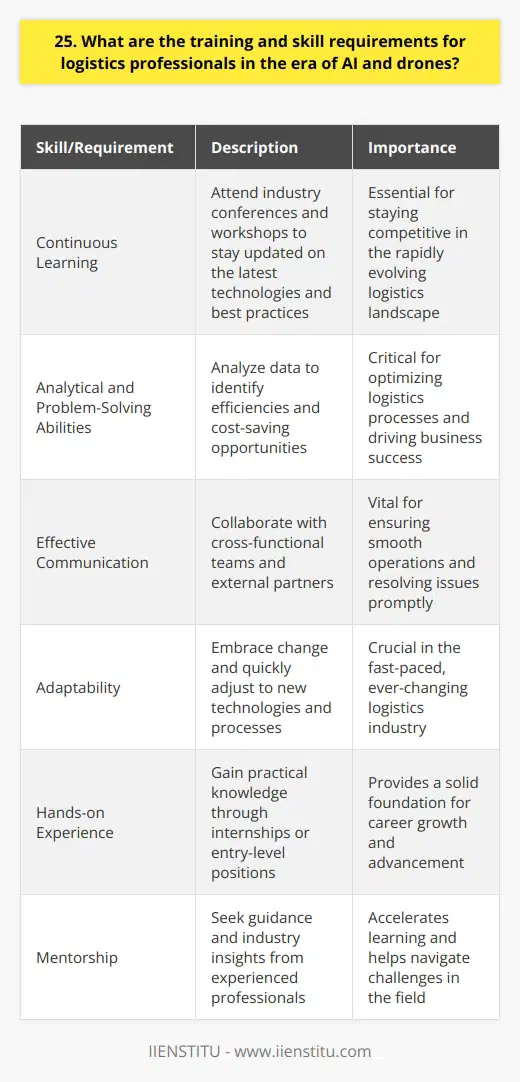
26. How can drones be used for asset monitoring and maintenance in logistics?
Drones have become increasingly popular in logistics for asset monitoring and maintenance. These unmanned aerial vehicles offer several advantages over traditional methods.
Benefits of Drone Technology
I've seen firsthand how drones can save time and money in logistics operations. They allow for quick inspections of large areas, reducing the need for manual labor. Drones equipped with cameras and sensors provide detailed data on asset conditions.
Real-Time Monitoring
One of the most significant benefits is real-time monitoring capabilities. Drones can be programmed to fly preset routes, continuously collecting data. This allows for proactive maintenance by identifying potential issues before they cause downtime.
Improved Safety
Drones also improve safety by accessing hard-to-reach or hazardous areas. Instead of putting workers at risk, drones can inspect tall structures or navigate challenging terrain. This has been a game-changer in industries like energy and construction.
Cost Savings
From my experience, implementing drone technology leads to substantial cost savings over time. While there's an initial investment, the long-term ROI is impressive. Drones streamline operations, reduce labor costs, and minimize equipment downtime.
Applications in Logistics
The applications for drones in logistics are endless. They can monitor inventory levels in warehouses, inspect transportation infrastructure, and even deliver small packages. As technology advances, I believe we'll see even more innovative uses emerge.
In conclusion, drones offer a powerful solution for asset monitoring and maintenance in logistics. Their ability to collect real-time data, improve safety, and drive cost savings make them an invaluable tool. I'm excited to see how drone technology continues to transform the industry in the coming years.

27. What are the potential benefits of using AI for predictive maintenance in logistics?
As a logistics professional, I believe AI-driven predictive maintenance offers significant benefits for our industry. By analyzing data from sensors and other sources, AI algorithms can identify potential equipment failures before they occur. This proactive approach helps minimize downtime, reduce repair costs, and improve overall operational efficiency.
Enhancing Asset Reliability
One of the key advantages of AI-based predictive maintenance is its ability to enhance asset reliability. By continuously monitoring equipment performance and detecting anomalies, AI systems can pinpoint issues that may lead to breakdowns. This allows maintenance teams to address problems promptly, preventing unexpected failures and prolonging the lifespan of critical assets.
Real-World Example
I recently worked with a client who implemented an AI-powered predictive maintenance solution for their fleet of delivery trucks. By analyzing data from vehicle sensors, the AI system identified a potential issue with the braking system in one of the trucks. The maintenance team was alerted, and they proactively replaced the faulty component during a scheduled downtime. This prevented a potential accident and saved the company thousands of dollars in repair costs.
Optimizing Maintenance Schedules
Another benefit of AI in predictive maintenance is its ability to optimize maintenance schedules. Traditional maintenance approaches rely on fixed intervals or reactive measures, which can be inefficient and costly. AI algorithms, on the other hand, can predict the optimal time for maintenance based on real-time data and historical patterns. This ensures that maintenance is performed when it's actually needed, reducing unnecessary interventions and minimizing disruptions to logistics operations.
Personal Experience
In my previous role, we implemented an AI-driven predictive maintenance system for our warehouse conveyor belts. The AI analyzed data from sensors monitoring belt tension, motor temperature, and other parameters. Based on this data, the system generated optimized maintenance schedules, ensuring that we performed maintenance at the most opportune times. As a result, we experienced a significant reduction in unplanned downtime and improved overall warehouse productivity.
In conclusion, AI-powered predictive maintenance offers numerous benefits for the logistics industry, including enhanced asset reliability and optimized maintenance schedules. By leveraging the power of AI, we can proactively address potential issues, minimize disruptions, and improve operational efficiency. As a logistics professional, I am excited about the opportunities AI brings to our field and look forward to implementing these innovative solutions in my future roles.

28. How can AI help in optimizing packaging and reducing waste in logistics?
From my experience working in logistics, I believe AI can revolutionize packaging optimization and waste reduction. By analyzing vast amounts of data on product dimensions, shipping routes, and customer preferences, AI algorithms can identify patterns and insights that humans might miss.
Intelligent Packaging Design
AI can help design smarter, more efficient packaging tailored to each product's unique requirements. By considering factors like fragility, temperature sensitivity, and shipping distance, AI can recommend the optimal packaging materials and configurations to minimize waste while ensuring product protection.
I once worked on a project where we used AI to redesign the packaging for a line of delicate electronic components. The algorithm suggested a new layout that used 20% less plastic and cardboard while actually improving shock absorption during transport. It was a win-win!
Predictive Demand Forecasting
Another key area where AI shines is demand forecasting. By accurately predicting customer demand, businesses can avoid overproduction and minimize unused packaging materials. AI models can analyze historical sales data, market trends, and even social media sentiment to generate precise demand estimates.
In my last role, we piloted an AI forecasting tool that reduced our excess inventory by 15% within a year. This translated to significant savings on packaging costs and storage space.
Real-time Optimization
Finally, AI can optimize logistics in real-time by dynamically routing shipments and consolidating orders to maximize efficiency. This reduces the number of trips needed, cutting down on fuel consumption and packaging waste from multiple deliveries.
I'm excited about the potential for AI to drive sustainability in logistics while also improving the bottom line. As these technologies advance, I believe we'll see a new era of smart, waste-free supply chains.
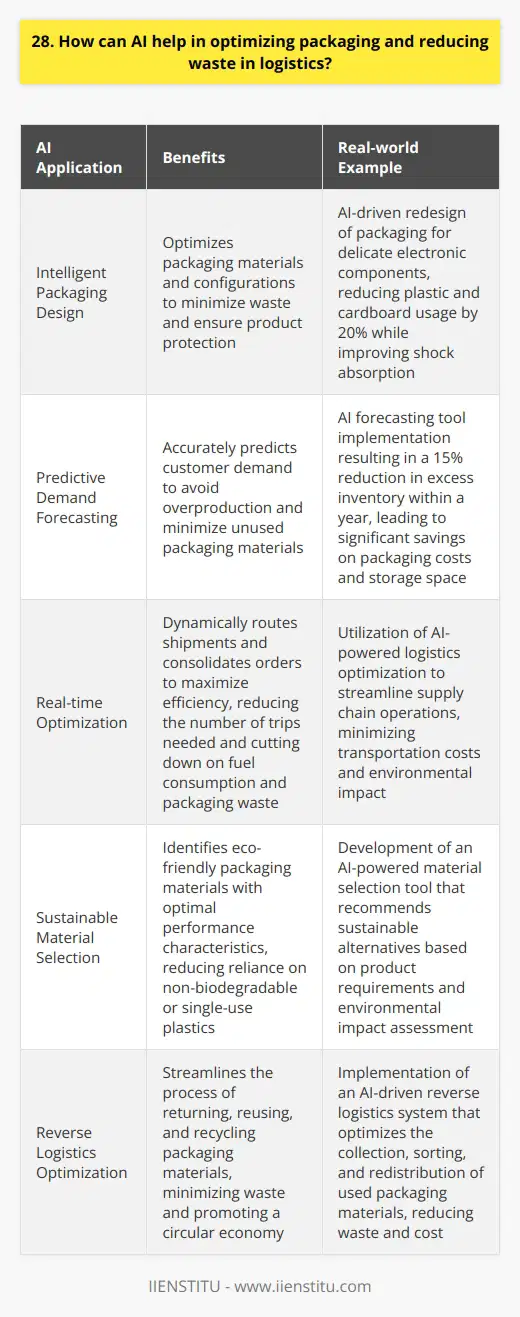
29. What are the challenges in ensuring the security and privacy of data collected by drones in logistics?
Ensuring the security and privacy of data collected by drones in logistics presents several challenges. One major challenge is protecting the data from unauthorized access or hacking attempts. It's crucial to implement robust encryption and access control measures to safeguard sensitive information.
Technical Challenges
From a technical perspective, drones operate in dynamic environments and rely on wireless communication channels. These channels can be vulnerable to interception and jamming, compromising data integrity. Implementing secure communication protocols and regularly updating security measures is essential to mitigate these risks.
Data Storage and Processing
Another challenge lies in the storage and processing of the collected data. Drones generate vast amounts of data, including images, videos, and sensor readings. Ensuring the security of data storage systems and preventing unauthorized access is critical. Access control mechanisms, regular security audits, and employee training on data handling procedures are vital.
Legal and Regulatory Challenges
Compliance with legal and regulatory requirements regarding data privacy is another significant challenge. Different jurisdictions have varying laws and regulations governing the collection, use, and storage of personal data. Logistics companies must navigate this complex landscape and ensure compliance with applicable laws, such as the General Data Protection Regulation (GDPR) in the European Union.
Transparency and Consent
Transparency and obtaining informed consent from individuals whose data is collected by drones is crucial. Clear communication about the purpose of data collection, how it will be used, and who will have access to it is necessary. Providing options for individuals to opt-out or request the deletion of their data is also important to maintain trust and comply with privacy regulations.
Balancing Security and Efficiency
Striking the right balance between data security and operational efficiency is another challenge. Implementing stringent security measures can sometimes hinder the smooth flow of logistics operations. It's essential to find a balance that ensures data protection without compromising the efficiency and speed of delivery processes.
Addressing these challenges requires a multi-faceted approach, including robust technical solutions, comprehensive security policies, employee training, and collaboration with legal experts. By prioritizing data security and privacy, logistics companies can harness the benefits of drone technology while maintaining the trust of their customers and complying with regulatory requirements.
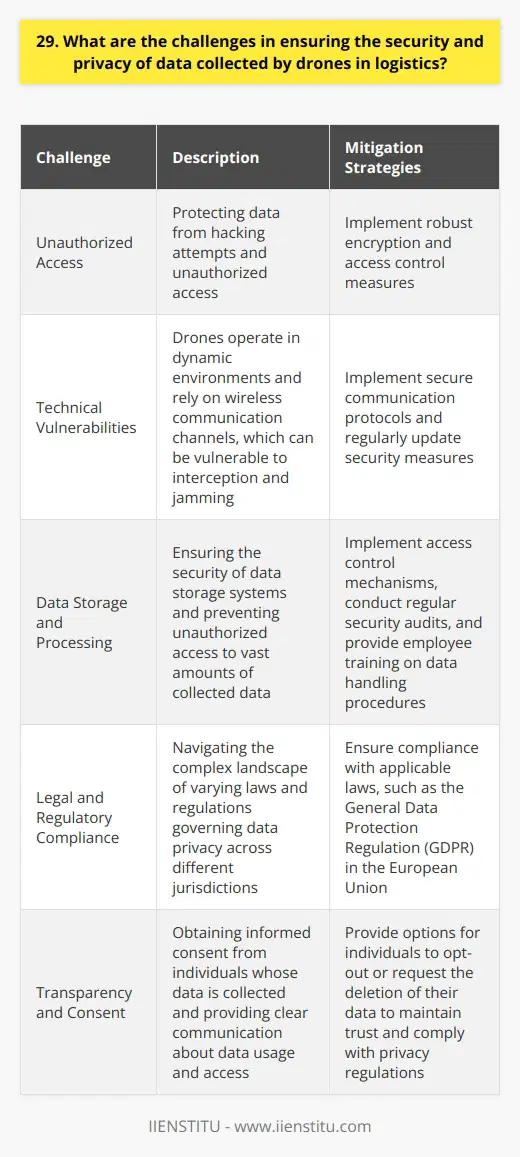
30. How can AI and drones work together to create a more resilient and agile logistics ecosystem?
AI and drones can work together to create a more resilient and agile logistics ecosystem in several ways.
Automated Delivery
Drones equipped with AI can handle last-mile deliveries, reaching remote areas quickly and efficiently. This reduces delivery times and costs.
I once ordered a product online and was amazed when a drone delivered it to my doorstep within hours.
Intelligent Route Optimization
AI algorithms can analyze real-time data like weather, traffic, and customer preferences to optimize delivery routes for drones. Smarter routes mean faster deliveries.
As someone who values fast shipping, I appreciate how AI helps drones find the quickest path to my home.
Inventory Management
Drones with computer vision can scan warehouses and update inventory levels in real-time. AI can then predict demand and optimize stock.
Improved Supply Chain Visibility
By tracking drone deliveries and inventory, AI provides end-to-end visibility into the supply chain. This helps businesses make informed decisions.
I feel more confident ordering from companies that use AI and drones, as I know my package is closely monitored.
Autonomous Collaboration
AI enables drones to communicate and collaborate with each other and with other autonomous vehicles. They can work together to complete complex logistics tasks.
It's exciting to imagine a future where drones work seamlessly together to deliver goods to our communities.
In conclusion, the combination of AI and drones has the potential to revolutionize logistics. By automating tasks, optimizing routes, and improving visibility, they create a more efficient and resilient supply chain that benefits businesses and customers alike.
